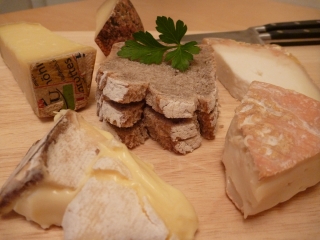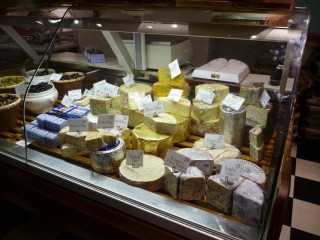Presumably a lot has been written about cheese. I wouldn’t know, I’ve never read anything on the subject, which is slightly surprising given how much I love the stuff. So this is my self-taught soliloquy on choosing cheeses for a cheese board. Surprising what you can learn from chatting to cheesemongers and sampling hundreds of cheeses over the years.
Now, I certainly don’t have a cheese course with every meal, oh no. If I detect from the menu that I’m going to be served three lumps of something entirely predictable (brie, stilton and cheshire for example) then I generally look for some pudding instead. Even if they’ve picked good makers and kept them well, I can buy and keep perfectly good lumps of these at home. Cheese is the one course in a restaurant where I can honestly say that I could (often) do it better myself. So, I only bother with the cheese course if I know that I’m going to be presented with a creaky little trolley crammed to bursting with a wide-ranging selection of cheeses that I can spend a happy five minutes cooing over, asking the waiter about, and generally reducing my dining companions to a slump of yawning boredom. Bliss!
Almost as much bliss as dithering in a well-stocked cheesemonger trying to decide which cheeses to take home and present on a nice wooden board to round off a meal with friends.
My cheese tastes have evolved, something I’ve managed to observe almost objectively (weird stuff, cheese). My first love affair was with anything repulsively stinky; rind-washed goo like Stinking Bishop and Epoisses. I still want something pungent on a cheese plate, but my tastes gradually shifted to an adoration of ripe and often ashed goat cheeses; Selles sur Cher and Sainte-Maure de Touraine are a couple of favourites, or Ragstone and Lightwood Capria from the UK. Perhaps three years ago I began to find a much higher proportion of blue cheeses in my semi-regular trips to the Teddington Cheese, as I ate my way through all kinds and found that they don’t get much better than Barkham Blue, or Cashel Blue for the Irish contingent. The blue cheese fad didn’t last, as I’ve matured (haha) now onto firm, salty cheeses like a good Manchego, or Premier Cru Gruyere, or local examples like the excellent Berkswell.
You can consider all those to be recommendations! Your cheese board cannot fail if you have one from each of those categories, along with some Montgomery’s Cheddar and a nice creamy specimen of Wigmore or Waterloo for those who fancy something milder.
Oh! Oh! Not forgetting some of the “specials” that don’t really fit a category. Gaperon is lovely, with a gentle garlicky taste. I generally despise flavoured cheeses in the UK – it’s usually some cruddy cheddar with a load of harsh chilli or whatever mixed into it. The French do it properly. Another example being the kooky Boulette d’Avesnes, flavoured with parsley, tarragon and paprika and delighting in the nickname ‘suppositoire du diable’. One truly great cheese you can only put on your board between October and April is Vacherin Mont d’Or, a gooey treat that holds a very slightly spicy flavour from the spruce bark it is wrapped in.
To tart up your cheese board I would personally suggest putting a big blob of quince paste in a gap between the cheeses, and tucking little clusters of 3-4 grapes snipped from the bunch in as well. I reckon quince paste makes a better accompaniment to the whole range of cheeses than most relishes and is also the One True Way to enjoy eating quince. And grapes are just a bit more appealing at the end of a meal than austere little sticks of celery.
I’m not sure what to say about bread and biscuits. It’s such a dry subject. HahahahaHA! Yes. I prefer some kind of artisan bread flavoured with something that goes well with cheese; walnut bread, for example. But a mixture of any quality bread and biscuits can’t go wrong.
Finally, I have a question for any erudite foodies reading this. Several years ago I had a French cheese on a cheese board at the Fat Duck that was creamy, rinded and with a pronounced saffron flavour. It was lovely, and I’ve never found it again nor been able to locate it on the internets. Any ideas?




